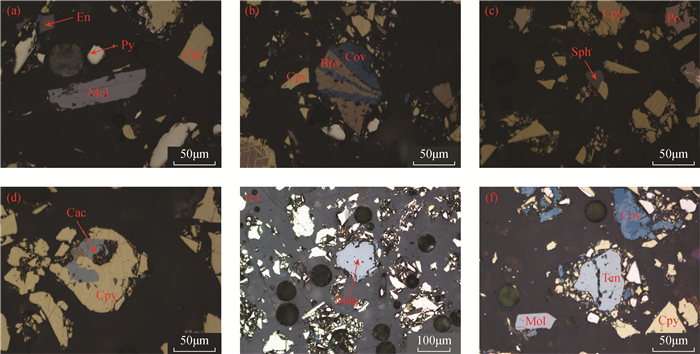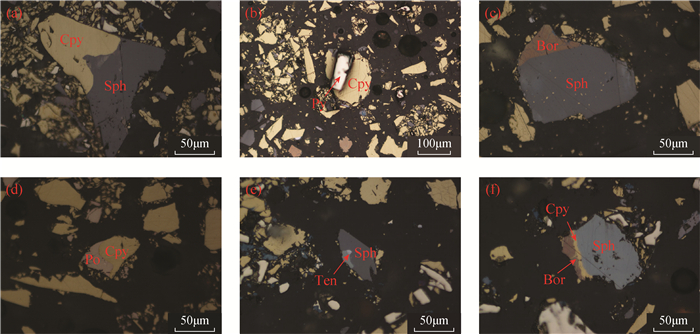Study on the Mineralogical Characteristics of 12 Copper Concentrates by X-ray Fluorescence Spectrometry, X-ray Powder Diffraction and Polarization Microscope
-
摘要:
我国是世界上最大的铜精矿进口国,研究不同产地铜精矿的矿物学特征,能支撑铜精矿原产地分析及相关固体废物属性鉴定。本文研究对象为来自8个国家12个矿区的进口铜精矿样品,采用X射线荧光光谱(XRF)、X射线粉晶衍射(XRD)以及偏光显微镜进行综合分析,探寻这些矿区铜精矿的元素组成、矿物组合特征,探讨不同成因类型铜精矿的矿物学差异。X射线荧光光谱分析表明铜精矿样品主要元素为Cu、Fe、S、O,普遍含有Zn、Si、Al、Mg、Ca、Pb;X射线粉晶衍射物相分析表明铜精矿样品主要物相为黄铜矿,其次常含有黄铁矿和闪锌矿等物相;偏光显微镜光片鉴定表明铜精矿样品金属矿物中黄铜矿的含量在88%~98%之间,观察到黄铜矿与闪锌矿、黄铁矿、磁黄铁矿共生,闪锌矿与斑铜矿、砷黝铜矿共生,黄铜矿、砷黝铜矿和斑铜矿共生等连生体矿相。结合铜精矿不同成矿类型分析表明,斑岩型、矽卡岩型、火山成因块状硫化型铜矿床样品中常见黄铜矿、黄铁矿、闪锌矿,并分别含有黑云母、草酸钙石、硫酸铅特征矿物;铁氧化物铜金矿床样品主要矿物为黄铜矿,常见磁黄铁矿、滑石特征矿物。通过本文采用多种技术表征不同产地铜精矿样品元素含量、物相组成、矿相组成的差异,能够全面分析不同产地铜精矿样品的矿物学特征,对进口铜精矿的风险识别和管控具有重要意义。
Abstract:BACKGROUND China is the largest importer of copper concentrate in the world. Studying the mineralogical characteristics of copper concentrates imported from different origins can be used to support the origin analysis and solid waste identification of copper concentrates.
OBJECTIVES To investigate the elemental composition and mineral assemblage characteristics of imported copper concentrates from different mining areas, and to discuss the mineralogical differences of copper concentrates of different genetic types.
METHODS The copper concentrates imported from different mining areas were comprehensively analyzed by X-ray fluorescence spectrometry (XRF), X-ray powder diffraction (XRD) and polarized microscopy (PM).
RESULTS X-ray fluorescence spectroscopy analysis showed that the main elements of the copper concentrates were Cu, Fe, S, O with minor Zn, Si, Al, Mg, Ca, Pb. X-ray powder diffraction phase analysis showed that the main phase of the copper concentrate sample was chalcopyrite, followed by pyrite and sphalerite. Polarization microscope showed that the content of chalcopyrite in copper concentrates was between 88% and 98%, and it was found that chalcopyrite was associated with sphalerite, pyrite and pyrrhotite, and that sphalerite was associated with bornite, arsenotetrahedrite. Chalcopyrite, arsenotetrahedrite and bornite form intergrowths. Combining the analysis of different genetic types of copper concentrates, samples of porphyry, skarn and VMS deposits were composed of chalcopyrite, pyrite and sphalerite with respective special minerals of biotite, weddellite and lead anglesite. The main minerals of the IOCG deposit samples were chalcopyrite, pyrrhotite and talc.
CONCLUSIONS Through the combination of XRF, XRD and PM, the elemental content and phase composition of copper concentrate samples were characterized. The mineralogical characteristics of copper concentrate samples from different origins have been more comprehensively analyzed, which is of great significance for risk identification and control of imported copper concentrates.
-

-
表 1 不同铜精矿样品产地及成矿类型信息
Table 1. Origin and metallogenic type information of different copper concentrates
样品编号 国别 矿区(英文名) 矿区(中文名) 成矿类型[28] Cu-1 澳大利亚 Eloise 埃洛伊斯 铁氧化物铜金型(IOCG) Cu-2 巴西 Sossego 索赛戈 铁氧化物铜金型(IOCG) Cu-3 厄立特里亚 Bisha 比萨 火山成因块状硫化物型(VMS) Cu-4 印度尼西亚 Grasberg 格拉斯伯格 斑岩型 Cu-5 美国 Pinto Valley 平托谷 斑岩型 Cu-6 墨西哥 Cananea 卡纳内阿 斑岩型 Cu-7 智利 Collahuasi 科亚瓦西 斑岩型 Cu-8 智利 Escondida 埃斯康迪达 斑岩型 Cu-9 智利 Los Pelambres 洛斯帕布兰雷斯 斑岩型 Cu-10 智利 Andina 安迪纳 斑岩型 Cu-11 秘鲁 Antamina 安塔米纳 矽卡岩型 Cu-12 秘鲁 Cerro Verde 赛罗佛尔迪 斑岩型 表 2 铜精矿样品中Cu/Fe、Cu/S及(CaO+MgO)/(SiO2+Al2O3)的比值
Table 2. Ratio of Cu/Fe, Cu/S and (CaO+MgO)/(SiO2+Al2O3) of copper concentrates
样品编号 国别 矿区 Cu/Fe Cu/S (CaO+MgO)/(SiO2+Al2O3) Cu-6 智利 Los Pelambres 1.5030 0.9688 0.0291 Cu-11 智利 Escondida 1.3392 0.9292 0.0320 Cu-10 印度尼西亚 Grasberg 1.1429 1.0024 0.1250 Cu-5 智利 Collahuasi 1.0949 0.9908 0.0354 Cu-2 巴西 Sossego 1.0748 1.1420 0.2441 Cu-7 智利 Andina 1.0376 1.0724 0.0425 Cu-8 美国 Pinto Valley 1.0004 1.1107 0.0400 Cu-4 秘鲁 Antamina 0.9918 1.0244 0.4327 Cu-9 墨西哥 Cananea 0.9875 1.0363 0.0228 Cu-12 秘鲁 Cerro Verde 0.9327 1.0632 0.0512 Cu-1 澳大利亚 Eloise 0.8749 1.2258 0.1551 Cu-3 厄立特里亚 Bisha 0.7991 0.9652 0.4007 表 3 铜精矿样品X射线粉晶衍射物相分析结果
Table 3. X-ray powder diffraction phase analysis of copper concentrates
样品编号 国别 矿区 成矿类型 X射线粉晶衍射谱图物相分析结果 Cu-1 澳大利亚 Eloise IOCG型 黄铜矿、石英、磁黄铁矿 Cu-2 巴西 Sossego IOCG型 黄铜矿、石英、滑石 Cu-3 厄立特里亚 Bisha VMS型 黄铜矿、黄铁矿、闪锌矿、滑石、硫酸铅矿 Cu-4 印度尼西亚 Grasberg 斑岩型 黄铜矿、黄铁矿、闪锌矿、石英、黑云母、斑铜矿 Cu-5 美国 Pinto Valley 斑岩型 黄铜矿、黄铁矿、闪锌矿、石英、勃姆石 Cu-6 墨西哥 Cananea 斑岩型 黄铜矿、黄铁矿、闪锌矿、石英、黑云母、勃姆石 Cu-7 智利 Collahuasi 斑岩型 黄铜矿、黄铁矿、闪锌矿、石英、黑云母、勃姆石、斑铜矿 Cu-8 智利 Escondida 斑岩型 黄铜矿、黄铁矿、闪锌矿、石英、黑云母、勃姆石 Cu-9 智利 Los Pelambres 斑岩型 黄铜矿、黄铁矿、闪锌矿、石英、黑云母 Cu-10 智利 Andina 斑岩型 黄铜矿、黄铁矿、闪锌矿、石英、黑云母 Cu-11 秘鲁 Antamina 矽卡岩型 黄铜矿、闪锌矿、黄铁矿、草酸钙石 Cu-12 秘鲁 Cerro Verde 斑岩型 黄铜矿、黄铁矿、闪锌矿、石英、黑云母 表 4 铜精矿偏光显微镜金属矿物鉴定结果
Table 4. Metal minerals in copper concentrate based on polarizing microscope observation
样品编号 国别 矿区 成矿类型 偏光显微镜观察光片鉴定结果 Cu-1 澳大利亚 Eloise IOCG型 黄铜矿98%+磁黄铁矿1%+黄铁矿+闪锌矿 Cu-2 巴西 Sossego IOCG型 黄铜矿98%+黄铁矿+斑铜矿+铜蓝 Cu-3 厄立特里亚 Bisha VMS型 黄铜矿97%+黄铁矿2%+闪锌矿+铜蓝 Cu-4 印度尼西亚 Grasberg 斑岩型 黄铜矿88%+斑铜矿7%+黄铁矿4%+闪锌矿+铜蓝+磁黄铁矿+辉钼矿 Cu-5 美国 Pinto Valley 斑岩型 黄铜矿98%+黄铁矿1%+铜蓝+磁铁矿+辉钼矿 Cu-6 墨西哥 Cananea 斑岩型 黄铜矿95%+闪锌矿2%+黄铁矿1%+铜蓝1% +辉钼矿+辉铜矿 Cu-7 智利 Collahuasi 斑岩型 黄铜矿91%+黄铁矿5%+斑铜矿2%+铜蓝1%+闪锌矿+辉钼矿+砷黝铜矿+硫砷铜矿 Cu-8 智利 Escondida 斑岩型 黄铜矿88%+黄铁矿5%+斑铜矿3%+铜蓝3%+闪锌矿+磁铁矿+辉钼矿+砷黝铜矿 Cu-9 智利 Los Pelambres 斑岩型 黄铜矿93%+黄铁矿3%+斑铜矿2%+铜蓝1%+闪锌矿+辉钼矿+砷黝铜矿 Cu-10 智利 Andina 斑岩型 黄铜矿99%+黄铁矿+闪锌矿+斑铜矿+铜蓝+辉铜矿 Cu-11 秘鲁 Antamina 矽卡岩型 黄铜矿98%+闪锌矿1%+黄铁矿+斑铜矿+辉钼矿+辉铜矿+砷黝铜矿 Cu-12 秘鲁 Cerro Verde 斑岩型 黄铜矿97%+铜蓝1%+黄铁矿1%+闪锌矿+辉钼矿 表 5 不同成矿类型铜精矿样品的元素含量及矿物学特征
Table 5. Element content and mineralogical characteristics of copper concentrate samples of different metallogenic types
成矿类型 样品编号 XRF分析特征元素含量 XRD分析特征物相 PM分析特征矿相 XRD结合PM分析共性特征 斑岩型 Cu-4、Cu-5、Cu-6、Cu-7、Cu-8、Cu-9、Cu-10、Cu-12 Si(3%~6%)Al(1%~3%) 黑云母 斑铜矿、辉钼矿 主要为黄铜矿,常见黄铁矿和闪锌矿 矽卡岩型 Cu-11 Ca(1.34%)Mg(0.274%) 草酸钙石 铜蓝、辉钼矿 IOCG型 Cu-1 Mg(0.23%)Al(0.37%)Si(1.37%) 磁黄铁矿 磁黄铁矿 Cu-2 Mg(2.13%)Al(1.18%)Si(5.66%) 滑石 斑铜矿、铜蓝 VMS型 Cu-3 Pb(3.29%) 硫酸铅矿 铜蓝 -
[1] Mitchell A H G.Mineral deposits and global tectonic settings[M].London: Academic Press Inc.Ltd, 1981.
[2] Hutchison C S. Economic deposits and their tectonic setting[M]. New York: Macmillan, 1983.
[3] Jankovic S. The copper deposits and geotectonic setting of the Thethyan Eurasian metallogenic belt[J]. Mineralium Deposita, 1977, 12(1): 37-47. doi: 10.1007/BF00204503
[4] Bradley D, Cand Leach D L. Tectonic controls of Mississippi Valley-type lead-zinc mineralization in orogenic forelands[J]. Mineralium Deposita, 2003, 38(6): 652-667. doi: 10.1007/s00126-003-0355-2
[5] Brzovic A, Villaescusa E. Rock mass characterization and assessment of block-forming geological discontinuities during caving of primary copper ore at the El Teniente mine, Chile[J]. International Journal of Rock Mechanics & Mining Sciences, 2007, 44(4): 565-583. http://www.sciencedirect.com/science/article/pii/S1365160906001493
[6] Lena V S, Emerson R, Craig A, et al. Spatial and temporal zoning of hydrothermal alteration and mineralization in the Sossego iron oxide copper gold deposit, Carajás Mineral Province, Brazil: Paragenesis and stable isotope constraints[J]. Mineralium Deposita, 2008, 43: 129-159. doi: 10.1007/s00126-006-0121-3
[7] Machault J, Barbanson L, Augé T, et al. Mineralogical and microtextural parameters in metals ores traceability studies[J]. Ore Geology Reviews, 2014, 63: 307-327. doi: 10.1016/j.oregeorev.2014.05.019
[8] Rozendaal A, Horn R. Textural, mineralogical and chemical characteristics of copper reverb furnace smelter slag of the Okiep Copper District, South Africa[J]. Minerals Engineering, 2013, 52: 184-190. doi: 10.1016/j.mineng.2013.06.020
[9] Soysouvanh V, Ariffin K S, Wantanabe K. Ore mineralogy and geochemistry of the Phu Kham Porphyry copper-gold deposit, Hosted within N-E Fault Zone, Lao PDR[J]. Procedia Chemistry, 2016, 19: 961-968. doi: 10.1016/j.proche.2016.03.142
[10] Velasco F, Herrero J M, Suárez S, et al. Supergene features and evolution of gossans capping massive sulphide deposits in the Iberian Pyrite Belt[J]. Ore Geology Reviews, 2013, 53: 181-203. doi: 10.1016/j.oregeorev.2013.01.008
[11] 梅燕雄, 裴荣富, 杨德凤, 等. 全球成矿域和成矿区带[J]. 矿床地质, 2009, 28(4): 383-389. https://www.cnki.com.cn/Article/CJFDTOTAL-KCDZ200904000.htm
Mei Y X, Pei R F, Yang D F, et al. Global metallogenic domains and districts[J]. Mineral Deposits, 2009, 28(4): 383-389. https://www.cnki.com.cn/Article/CJFDTOTAL-KCDZ200904000.htm
[12] 张强, 钟琼, 贾振宏, 等. 世界铜矿资源与矿山铜生产状况分析[J]. 矿产与地质, 2014, 28(2): 196-201. https://www.cnki.com.cn/Article/CJFDTOTAL-KCYD201402012.htm
Zhang Q, Zhong Q, Jia Z H, et al. An analysis on global copper ore resource and copper production of mines[J]. Mineral Resources and Geology, 2014, 28(2): 196-201. https://www.cnki.com.cn/Article/CJFDTOTAL-KCYD201402012.htm
[13] 刘喜锋, 贾玉衡, 刘琰. 新疆若羌-且末戈壁料软玉的地球化学特征及成因类型研究[J]. 岩矿测试, 2019, 38(3): 316-325. http://www.ykcs.ac.cn/article/doi/10.15898/j.cnki.11-2131/td.2015.05.003
Liu X F, Jia Y H, Liu Y. Geochemical characteristics and genetic types of Gobi nephrite in Ruoqiang-Qiemo, Xinjiang[J]. Rock and Mineral Analysis, 2019, 38(3): 316-325. http://www.ykcs.ac.cn/article/doi/10.15898/j.cnki.11-2131/td.2015.05.003
[14] Seetha D, Velraj G. FT-IR, XRD, SEM-EDS, EDXRF and chemometric analyses of archaeological artifacts recently excavated from Chandravalli in Karnataka State, South India[J]. Radiation Physics and Chemistry, 2019, 162: 114-120. doi: 10.1016/j.radphyschem.2019.03.017
[15] Murat H, Necdet T. A combined polarizing microscope, XRD, SEM, and specific gravity study of the petrified woods of volcanic origin from the Camlidere-Celtikci-Gudul fossil forest, in Ankara, Turkey[J]. Journal of African Earth Sciences, 2009, 53: 141-157. doi: 10.1016/j.jafrearsci.2009.01.001
[16] 孟长峰, 薛俊辉. X射线荧光光谱-X射线衍射研究宁夏贺兰石岩石矿物学特征[J]. 岩矿测试, 2018, 37(1): 50-55. http://www.ykcs.ac.cn/article/doi/10.15898/j.cnki.11-2131/td.2015.05.003
Meng C F, Xue J H. Study on petrological and mineralogical characteristics of the Ningxia Helan stone by X-ray fluorescence spectrometry and X-ray diffraction[J]. Rock and Mineral Analysis, 2018, 37(1): 50-55. http://www.ykcs.ac.cn/article/doi/10.15898/j.cnki.11-2131/td.2015.05.003
[17] 刘倩, 秦晔琼, 刘曙, 等. X射线荧光光谱结合BP神经网络识别进口铜精矿产地[J]. 光谱学与光谱分析, 2020, 40(9): 2884-2890. https://www.cnki.com.cn/Article/CJFDTOTAL-GUAN202009043.htm
Liu Q, Qin Y Q, Liu S, et al. X-ray fluorescence spectroscopy combined with BP neural network to identify imported copper concentrate origin[J]. Spectroscopy and Spectral Analysis, 2020, 40(9): 2884-2890. https://www.cnki.com.cn/Article/CJFDTOTAL-GUAN202009043.htm
[18] 刘喜锋, 张红清, 刘琰, 等. 世界范围内代表性碧玉的矿物特征和成因研究[J]. 岩矿测试, 2018, 37(5): 479-489. http://www.ykcs.ac.cn/article/doi/10.15898/j.cnki.11-2131/td.201712010187
Liu X F, Zhang H Q, Liu Y, et al. Mineralogical characteristics and genesis of green nephrite from the world[J]. Rock and Mineral Analysis, 2018, 37(5): 497-489. http://www.ykcs.ac.cn/article/doi/10.15898/j.cnki.11-2131/td.201712010187
[19] 李欣桐, 先怡衡, 樊静怡, 等. 应用扫描电镜-X射线衍射-电子探针技术研究河南淅川绿松石矿物学特征[J]. 岩矿测试, 2019, 38(4): 373-381. http://www.ykcs.ac.cn/article/doi/10.15898/j.cnki.11-2131/td.201809090102
Li X T, Xian Y H, Fan J Y, et al. Application of XRD-SEM-XRD-EMPA to study the mineralogical characteristics of turquoise from Xichuan, Henan Province[J]. Rock and Mineral Analysis, 2019, 38(4): 373-381. http://www.ykcs.ac.cn/article/doi/10.15898/j.cnki.11-2131/td.201809090102
[20] Hupp N, Donovan J. Quantitative mineralogy for facies definition in the Marcellus shale (Appalachian Basin, USA) using XRD-XRF integration[J]. Sedimentary Geology, 2018, 371: 16-31. doi: 10.1016/j.sedgeo.2018.04.007
[21] 吕新明, 田延河, 宁海龙, 等. 波长色散X射线荧光光谱仪和多晶X射线衍射仪联用技术鉴定进口铜矿和含铜物料[J]. 中国无机分析化学, 2018, 8(4): 21-25. https://www.cnki.com.cn/Article/CJFDTOTAL-WJFX201804006.htm
Lv X M, Tian Y H, Ning H L, et al. Indentification of imports of copper materials by wavelength dispersive X-ray fluorescence (XRF) spectrometer and polycrystalline X-ray diffraction (XRD) spectrometry[J]. Chinese Journal of Inorganic Analytical Chemistry, 2018, 8(4): 21-25. https://www.cnki.com.cn/Article/CJFDTOTAL-WJFX201804006.htm
[22] 宋义, 古松海, 孙鑫, 等. 铜精矿与铜冶炼渣的物相鉴别[J]. 冶金分析, 2015, 35(3): 25-31. https://www.cnki.com.cn/Article/CJFDTOTAL-YJFX201503006.htm
Song Y, Gu S H, Sun X, et al. Phase identification of copper concentrate and copper smelting slag[J]. Metallurgical Analysis, 2015, 35(3): 25-31. https://www.cnki.com.cn/Article/CJFDTOTAL-YJFX201503006.htm
[23] 咸洋, 闵红, 朱之秀, 等. 多技术联用鉴别含铜物料固体废物属性[J]. 机械工程材料, 2018, 12(42): 18-26. https://www.cnki.com.cn/Article/CJFDTOTAL-GXGC201812005.htm
Xian Y, Min H, Zhu Z X, et al. Solid waste characteristic identification of copper-containing materials with a variety of techniques[J]. Materials for Mechanical Engineering, 2018, 12(42): 18-26. https://www.cnki.com.cn/Article/CJFDTOTAL-GXGC201812005.htm
[24] Deckart K, Silva W, Sprohnle C, et al. Timing and dur-ation of hydrothermal activity at the Los Bronces porphyry cluster: An update[J]. Mineralium Deposita, 2014, 49: 535-546. doi: 10.1007/s00126-014-0512-9
[25] Seedorff E, Dilles H, Proffett M, et al. Porphyry deposits: Characteristics and origin of hypogene features[J]. Society of Economic Geologists, 2005, 100: 251-298. http://ci.nii.ac.jp/naid/10030173981
[26] 毛景文, 罗茂澄, 谢桂青, 等. 斑岩铜矿床的基本特征和研究勘查新进展[J]. 地质学报, 2014, 88(12): 2153-2175. https://www.cnki.com.cn/Article/CJFDTOTAL-DZXE201412002.htm
Mao J W, Luo M C, Xie G Q, et al. Basic characteristics and new advances in research and exploration on porphyry copper deposits[J]. Acta Geologica Sinica, 2014, 88(12): 2153-2175. https://www.cnki.com.cn/Article/CJFDTOTAL-DZXE201412002.htm
[27] 瞿泓滢, 裴荣富, 梅燕雄, 等. 国外超大型-特大型铜矿床成矿特征[J]. 中国地质, 2013, 40(2): 371-390. https://www.cnki.com.cn/Article/CJFDTOTAL-DIZI201302003.htm
Qu H Y, Pei R F, Mei Y X, et al. Metallogenic characteristics of superlarge and exceptional superlarge Cu deposits abroad[J]. Geology in China, 2013, 40(2): 371-390. https://www.cnki.com.cn/Article/CJFDTOTAL-DIZI201302003.htm
[28] 周平, 唐金荣, 杨宗喜, 等. 铜矿资源战略分析[M]. 北京: 地质出版社, 2012.
Zhou P, Tang J R, Yang Z X, et al. Strategic analysis of copper resources[M]. Beijing: Geological Publishing House, 2012.
[29] 胡树起, 马生明, 刘崇民. 斑岩型铜矿勘查地球化学研究现状及进展[J]. 物化与化探, 2011, 35(4): 431-437. https://www.cnki.com.cn/Article/CJFDTOTAL-WTYH201104002.htm
Hu S Q, Ma S M, Liu C M. The present situation and research advances of exploration geochemistry for porphyry copper deposits[J]. Geophysical & Geochemical Exploration, 2011, 35(4): 431-437. https://www.cnki.com.cn/Article/CJFDTOTAL-WTYH201104002.htm
[30] Lee C T A, Tang M. How to make porphyry deposits[J]. Earth and Planetary Science Letters, 2020, 628(11): 58-68.
[31] 翟裕生, 姚书振, 蔡克勤. 矿床学[M]. 北京: 地质出版社, 2011.
Zhai Y S, Yao S Z, Cai K Q. Deposits[M]. Beijing: Geological Publishing House, 2011.
[32] Lena V S, Roberto P, Murray W, et al. Mineral chemistry of ore and hydrothermal alteration at the Sossego iron oxide-copper-gold deposit, Carajas mineral province, Brazil[J]. Ore Geology Reviews, 2008, 37: 317-336. http://www.sciencedirect.com/science/article/pii/S0169136808000048
[33] 刘心同, 孙健. 铜矿贸易与质量检测[M]. 青岛: 中国海洋出版社, 2016.
Liu X T, Sun J. Copper ore trade and quality inspection[M]. Qingdao: China Ocean Press, 2016.
[34] Chen H Y. External sulphur in IOCG mineralization: Implications on definition and classification of the IOCG clan[J]. Ore Geology Reviews, 2013, 51: 74-78. doi: 10.1016/j.oregeorev.2012.12.002
[35] Franklin J M, Gibson H L, Jonasson I R, et al. Volcan-ogenic massive sulfide deposits[J]. Economic Geologists, 2005, 100: 523-560.
-




 下载:
下载:


